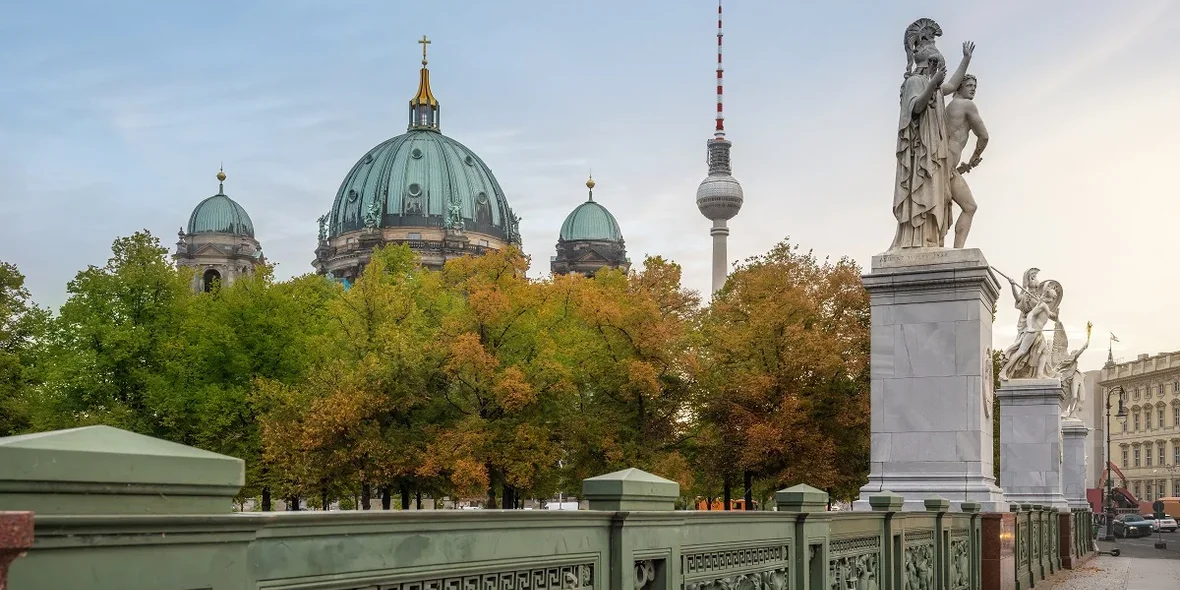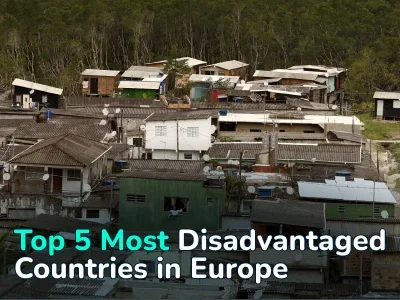
Where to Live in Berlin: Overview of Neighborhoods with Prices From €3500 to €15,000 Per m²
Berlin remains a highly sought-after city for real estate investment and permanent residence. Like other global capitals, it concentrates not only Germany’s major industrial enterprises but also the headquarters of international companies such as SAP and Zalando. These major brands attract a significant number of labor migrants who settle in the city permanently.
Another important segment of the local population consists of students enrolled at renowned German universities, including Humboldt University and the Free University of Berlin.
Berlin is a large city, divided into 12 districts (Bezirke) and numerous neighborhoods (Kieze), offering something for everyone — whether they are workers, students, or investors. In this article, we will explore which districts are best suited for living in Berlin in 2025.
Best Districts for Families
Families tend to choose the safest districts with international schools, parks, and green spaces. Prenzlauer Berg (Pankow) fits these criteria best. Rental prices here start from €18—25/m², while purchase prices range from €6000—8500/m².
Charlottenburg-Wilmersdorf is another family-friendly option — a prestigious central district home to the Charlottenburg Palace and the international Berlin British School. Rental prices here are slightly lower than in Prenzlauer Berg, ranging from €16—22/m², with purchase prices between €5500—8000/m².
A more budget-friendly option is Steglitz-Zehlendorf, a suburban district located farther from the city center, known for its lakes and forests. Rents here range from €12—18/m², while purchase prices start at €4500—6500/m².
Best Districts for Students and Young Professionals
Students and young professionals look for affordable housing, proximity to universities, and a vibrant urban lifestyle. Kreuzberg (Friedrichshain-Kreuzberg) is particularly appealing due to its multicultural vibe, numerous clubs, and the popular Tempelhofer Feld park. Rental rates here are around €16—22/m², with purchase prices between €5500—7500/m².
Friedrichshain is especially popular among IT professionals. Numerous startups have emerged here thanks to favorable government support policies. The surrounding infrastructure — clubs, bars, and cafés — caters to a younger crowd. Property prices are about 5–7% lower than in Kreuzberg.
A more budget-conscious choice is Neukölln, especially the Schillerkiez area, which is particularly popular among students. Rental prices are €14—18/m², while property purchases cost €4500—6500/m².
Best Districts for Expats
Expats often choose neighborhoods with an international atmosphere and widespread use of English. Mitte is Berlin’s central district, home to Silicon Allee, the Brandenburg Gate, and numerous coworking spaces — ideal for professionals. It is one of the more expensive areas, with property prices ranging from €6500—9000/m².
Schöneberg (Tempelhof-Schöneberg) is known for its inclusivity and vibrant LGBTQ+ community, which provides a strong sense of solidarity and belonging. Rental prices range from €15—20/m², while buying property costs €5000—7000/m².
A quieter and more versatile option is Wedding, where the main appeal lies in more affordable housing compared to the two districts above. Rents start at €12—16/m², and purchase prices range from €4000—6000/m².
Comparative Table of Berlin Districts
Based on the data and neighborhoods discussed above, we have compiled two tables to help you choose the most suitable district according to your budget, lifestyle, and personal priorities.
|
District |
Best For |
Pros |
Cons |
|
Prenzlauer Berg |
Families, Expats |
Safety, schools, parks (Kollwitzplatz) |
High rent, tourist crowds |
|
Charlottenburg-Wilmersdorf |
Families, Expats |
Prestige, international schools, Ku’damm shopping |
Expensive, quieter atmosphere |
|
Steglitz-Zehlendorf |
Families |
Peaceful, forests, schools (BBIS) |
Far from city center |
|
Kreuzberg |
Students, Professionals |
Nightlife, Tempelhofer Feld, Graefekiez |
Noisy, housing shortage |
|
Friedrichshain |
Students, Professionals |
Startups, clubs (Berghain), Boxhagener Platz |
Noisy, tourist-heavy |
|
Neukölln |
Students, Expats |
Affordable, Schillerkiez, multicultural |
Dirty in places, mixed reputation |
|
Mitte |
Expats, Professionals |
Central location, Silicon Allee, coworking spaces |
Expensive, tourist crowds |
|
Schöneberg |
Expats, Families |
Cozy, LGBTQ+-friendly, good schools |
Less trendy |
|
Wedding |
Expats, Students |
Affordable, multicultural environment |
Some areas less safe |
Average rental and property prices in Berlin districts:
|
District |
Rent (€/m²) |
Purchase Price (€/m²) |
Time to City Center (min) |
|
Prenzlauer Berg |
18–25 |
6000–8500 |
10–15 |
|
Charlottenburg-Wilmersdorf |
16–22 |
5500–8000 |
15–20 |
|
Steglitz-Zehlendorf |
12–18 |
4500–6500 |
30–40 |
|
Kreuzberg |
16–22 |
5500–7500 |
10–15 |
|
Friedrichshain |
15–20 |
5000–7000 |
10–15 |
|
Neukölln |
14–18 |
4500–6500 |
15–20 |
|
Mitte |
18–25 |
6500–9000 |
0–10 |
|
Schöneberg |
15–20 |
5000–7000 |
15–20 |
|
Wedding |
12–16 |
4000–6000 |
10–15 |
Most Safe Places in Berlin
Berlin is considered one of the safest major cities in Europe, with a safety index of 57.76 in 2025, which is higher than in Paris or London. The overall crime rate is moderate: in 2024, approximately 950,000 criminal incidents were reported in a city of 3.7 million residents. Most of these involve pickpocketing, fraud, and minor offenses, primarily concentrated in tourist-heavy areas. In residential districts, crime is significantly less frequent.
Safest districts in Berlin:
- Charlottenburg-Wilmersdorf. A prestigious western district with one of the lowest crime rates in the city. It is popular among families and affluent residents. Police presence is high, and incidents are rare, except for occasional petty theft.
- Prenzlauer Berg (Pankow). A family-oriented neighborhood known for its playgrounds and green areas. The low crime rate makes it ideal for families and expats. The main risk here is, again, pickpocketing — especially in busy areas during weekends.
- Steglitz-Zehlendorf. This suburban district is often regarded as the safest area in Berlin, with virtually no street crime. It’s favored by those seeking a quiet, residential environment.
- Schöneberg (Tempelhof-Schöneberg). A peaceful and inclusive neighborhood with a generally low crime rate. However, around Nollendorfplatz, minor thefts can occasionally occur.
While Berlin is generally safe, some locations are best approached with caution, particularly after dark. The main issues involve pickpocketing, drug-related activity, and occasional muggings.
- Alexanderplatz (Mitte). A central square with heavy tourist traffic and a correspondingly high rate of theft.
- Görlitzer Park (Kreuzberg). Popular during the day but known for drug dealing and safety concerns at night.
- Kottbusser Tor (Kreuzberg). A nightlife hotspot with a reputation for street altercations and open drug trade.
Districts like Neukölln, Wedding, and Kreuzberg are home to large Turkish and Arab communities and are generally safe. However, specific areas such as Hermannplatz (Neukölln) and Leopoldplatz (Wedding) can feel unsafe at night due to low-level crime and loitering. These places shouldn’t be strictly avoided, but common-sense precautions are advised — check local reviews when renting, avoid poorly lit streets, and don’t walk alone late at night.
Where Do the Wealthy Live in Berlin?
Berlin offers several prestigious districts favored by affluent residents, business owners, and real estate investors. These areas feature high-end properties in close proximity to cultural landmarks, luxury shopping, and key business centers. Below are the main districts preferred by the wealthy:
Charlottenburg-Wilmersdorf. One of Berlin’s most exclusive areas, centered around Kurfürstendamm (Ku’damm) — the city’s main luxury shopping boulevard, home to brands like Gucci and Chanel. The district also boasts fine dining restaurants and cultural institutions such as the Deutsche Oper. Property prices often start at €10,000/m², yet demand remains high, particularly among expats and diplomats.
Mitte. Located in central Berlin, this district includes prestigious residential buildings along Unter den Linden and new developments along the Spree River. It’s especially popular with senior executives from major firms like SAP and Zalando. Average property prices are around €8000/m², while luxury apartments can reach €12,000/m².
Grunewald. This exclusive enclave is known for its villas and is home to celebrities, cultural figures, and political elites. It offers spacious estates with private plots — a rarity in Berlin. Prices here typically range between €12,000—15,000/m².
Dahlem (Steglitz-Zehlendorf). Although a suburban area, Dahlem is popular among Germany’s academic and business elite due to its proximity to Freie Universität Berlin and several scientific institutions. It’s a residential choice for professors, diplomats, and families connected to international organizations. Property prices are slightly more modest than in the districts above, but still far from affordable, around €8000—10,000/m².
Most Affordable Districts in Berlin
Berlin also offers housing options for students, young professionals, expats, and families with limited budgets. Most affordable properties are located on the outskirts, but there are still reasonably priced options closer to the city center.
Wedding. Gaining popularity for its balance of price and centrality, Wedding was historically a working-class area with modest apartment blocks. Today, the neighborhood is undergoing active gentrification, with new cafés, art galleries, and coworking spaces emerging. Property prices range between €4000—6000/m². New developments are more expensive and safer, while older buildings often house immigrant families.
Lichtenberg. Located in East Berlin, this district is dominated by GDR-era architecture, which contributes to its lower prestige compared to Western districts. However, it offers some of Berlin’s lowest real estate prices — between €4000—5500/m² — and sufficient infrastructure for everyday life.
Marzahn-Hellersdorf. Considered the most budget-friendly borough in Berlin, this district also features socialist-era buildings. Despite its reputation, it is currently undergoing modernization, including infrastructure upgrades and residential improvements. Prices range from €3500—5000/m², and the area offers all essential amenities: schools, parks, kindergartens, and large shopping centers like Eastgate.
Spandau. A western borough on the outer edge of Berlin, Spandau offers relatively affordable housing at €4000—5500/m², making it popular among families. The main drawback is its distance from the city center: 25–35 minutes by car and up to one hour by public transport.
In Summary
Berlin is a city where everyone can find their place. Families enjoy comfort in the peaceful districts of Prenzlauer Berg and Steglitz-Zehlendorf, while students and young professionals thrive on the energy of Kreuzberg and Friedrichshain. Expats are drawn to the international atmosphere of Mitte and Schöneberg. Affluent residents favor the upscale areas of Charlottenburg and Grunewald, while those seeking more affordable options turn to the multicultural neighborhoods of Wedding and Lichtenberg. Explore the city, evaluate your priorities, and the choice of the perfect district will be yours.
Frequently Asked Questions
What is the best neighborhood in Berlin to buy real estate for investment?
The emerging neighborhoods of Wedding and Lichtenberg, with prices from €4000/m², are suitable for investment. They are showing an increase in property values due to gentrification.
How much does it cost to buy an apartment in the center of Berlin?
In the central Mitte district, prices range from €6500–9000/m², for the luxury segment up to €12,000/m². An average 70m² apartment will cost €455,000-630,000.
What is the safest neighborhood in Berlin for families?
Steglitz-Zehlendorf is considered the safest, with virtually no street crime. Alternatives include Charlottenburg-Wilmersdorf and Prenzlauer Berg.
Where is the cheapest place to rent in Berlin?
The lowest rents are in Wedding (€12-16/m²), Marzahn-Hellersdorf, and Lichtenberg. Students choose Neukölln (€14-18/m²).
Do I need to know German to live in Berlin?
In the international districts of Mitte, Prenzlauer Berg, and Schöneberg, you can get by with English, but basic German will make everyday life easier.
Author
I write informative articles about real estate, investments, job opportunities, taxes, etc.





















